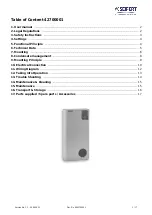
Rittal Liquid Cooling Package
51
16 Glossary
EN
16
Glossary
1 U server:
1 U servers are very flat and deep, modern high per-
formance servers, whose height corresponds to one
height unit (1 U = 44.54 mm, the smallest standard
height division). Typical dimensions are (W x H x D)
482.6 mm (19") x 1 U x 800 mm.
These systems normally include 2 CPUs, multiple GB
of RAM and hard drives, so that they require up to
100 m³/h cooling air at a maximum of 32°C.
482.6 mm (19") level:
The front of the devices built into the server enclosure
form the 482.6 mm (19") level.
Blade server:
By orienting dual CPU systems vertically and placing
up to 14 units on a common backplane to provide for
signal routing and power supply, a blade server is cre-
ated.
Blade servers can "generate" up to 4.5 kW heat loss
per 7 U and 700 mm depth.
Hot spot:
A hot spot is the concentration of thermal energy in a
small area.
Hot spots normally lead to local overheating and can
cause system malfunctions.
Air/water heat exchanger:
Air/water heat exchangers operate according to the
same principle as automobile radiators. A liquid (water)
flows through the heat exchanger, while, at the same
time, air is blown over its surface area (which is as
large as possible), facilitating energy exchange.
Depending on the temperature of the circulating liquid
(water), an air/water heat exchanger may either heat or
cool the circulated air.
Recooling system:
As an initial comparison, a recooling system is like a
refrigerator – although unlike a household refrigerator,
a recooling system produces cold water via an active
cooling circuit. The thermal energy which is removed
from the water is dissipated to the outside by fans. Be-
cause of this, it is normally advisable to locate recool-
ing systems outside of buildings.
Recooling systems and air/water heat exchangers
form a complete cooling solution.
Switch:
Multiple servers normally communicate with one an-
other and in the network using switches.
Because as many inputs as possible are located on
the front of switches, they frequently have an airflow
from the side, not "front to back" cooling.


















